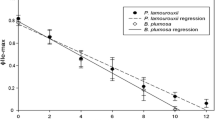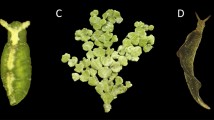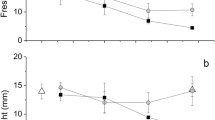Abstract
Sacoglossan sea slugs can ‘steal’ chloroplasts from their algal food and use them for photosynthesis (kleptoplasty). Although it has been shown that light has positive effects on survival and body size retention of some sacoglossans likely through photosynthesis, it is unknown whether light affects their fitness components such as number of offspring or offspring size. Moreover, whether the effects of light extend over the sacoglossans’ lifetime has been unexplored. To assess such long-term effects of light intensity and food availability on fitness components, we conducted a 15.9-week laboratory experiment using Elysia atroviridis under a combination of two light intensities (low or high) and two food conditions (with or without food). The total number of eggs laid was greater in the presence of both strong light and food than in other conditions, suggesting positive effects of both light intensity and food availability. The shell height at hatch was also largest in the presence of strong light and food. Larval rearing experiments showed that the size difference at hatch between conditions corresponded to a 1.19–1.93 days growth and 7.9–18.1% survival increase. Thus, positive effects of light and food on the fitness components extend over the lifetime of E. atroviridis.






Similar content being viewed by others
Data availability
The datasets supporting this article have been uploaded as part of the electronic supplementary material.
References
Akimoto A, Hirano YM, Sakai A, Yusa Y (2014) Relative importance and interactive effects of photosynthesis and food in two solar-powered sea slugs. Mar Biol 161:1095–1102. https://doi.org/10.1007/s00227-014-2402-1
Baumgartner FB, Pavia H, Toth GB (2015) Acquired phototrophy through retention of functional chloroplasts increases growth efficiency of the sea slug Elysia viridis. PLoS ONE 10:e0120874. https://doi.org/10.1371/journal.pone.0120874
Bernhard JM, Bowser SS (1999) Benthic foraminifera of dysoxic sediments: chloroplast sequestration and functional morphology. Earth Sci Rev 46:149–165. https://doi.org/10.1016/S0012-8252(99)00017-3
Bhattacharya D, Pelletreau KN, Price DC, Sarver KE, Rumpho ME (2013) Genome analysis of Elysia chlorotica egg DNA provides no evidence for horizontal gene transfer into the germ line of this kleptoplastic mollusc. Mol Biol Evol 30:1843–1852. https://doi.org/10.1093/molbev/mst084
Cartaxana P, Trampe E, Kühl M, Cruz S (2017) Kleptoplast photosynthesis is nutritionally relevant in the sea slug Elysia viridis. Sci Rep 7:7714. https://doi.org/10.1038/s41598-017-08002-0
Cartaxana P, Rey F, Ribeiro M, Moreira ASP, Domingues MRM, Calado RC, Cruz S (2019) Nutritional state determines reproductive investment in the mixotrophic sea slugs Elysia viridis. Mar Ecol Prog Ser 611:167–177. https://doi.org/10.3354/meps12866
Christa G, Zimorski V, Woehle C, Tielens AGM, Wägele H, Martin WF, Gould SB (2013) Plastid-bearing sea slugs fix CO2 in the light but do not require photosynthesis to survive. Proc R Soc B Biol Sci 281:20132493. https://doi.org/10.1098/rspb.2013.2493
Christa G, Händeler K, Kück P, Vleugels M, Franken J, Karmeinski D, Wägele H (2014) Phylogenetic evidence for multiple independent origins of functional kleptoplasty in Sacoglossa (Heterobranchia, Gastropoda). Org Divers Evol 15:23–36. https://doi.org/10.1007/s13127-014-0189-z
Clark KB, Busacca M, Stirts H (1979) Nutritional aspects of the development of the ascoglossan, Elysia cauze. In: Stancyk SE (ed) Reproductive ecology of marine invertebrates. University of South Carolina Press, Columbia, pp 11–24
Clark KB, Jensen KR, Stirts HM (1990) Survey for functional kleptoplasty among West Atlantic Ascoglossa (= Sacoglossa) (Mollusca: Opistobranchia). Veliger 33:339–345
Curtis NE, Schwartz JA, Pierce SK (2010) Ultrastructure of sequestered chloroplasts in sacoglossan gastropods with differing abilities for plastid uptake and maintenance. Invertebr Biol 129:297–308. https://doi.org/10.1111/j.1744-7410.2010.00206.x
de Vries J, Christa G, Gould SB (2014) Plastid survival in the cytosol of animal cells. Trend Plant Sci 19:347–350. https://doi.org/10.1016/j.tplants.2014.03.010
Donohoo SA, Wade RM, Sherwood AR (2020) Finding the sweet spot: sub-ambient light increases fitness and kleptoplast survival in the sea slug Plakobranchus cf. ianthobaptus Gould, 1852. Biol Bull 238:154–166. https://doi.org/10.1086/709371
Dunlap MFS (1975) Symbiosis between algal chloroplasts and the mollusk Plakobranchus ocellatus van Hasselt (Sacoglossa: Opisthobranchia). PhD dissertation, University of Hawaii
Evertsen J, Johnsen G (2009) In vivo and in vitro differences in chloroplast functionality in the two north Atlantic sacoglossans (Gastropoda, Opisthobranchia) Placida dendritica and Elysia viridis. Mar Biol 156:847–859. https://doi.org/10.1007/s00227-009-1128-y
Evertsen J, Burghardt I, Johnsen G, Wägele H (2007) Retention of functional chloroplasts in some sacoglossans from the Indo-Pacific and Mediterranean. Mar Biol 151:2159–2166. https://doi.org/10.1007/s00227-007-0648-6
Fleming IA, Gross MR (1990) Latitudinal clines: a trade-off between egg number and size in Pacific salmon. Ecology 71:1–11. https://doi.org/10.2307/1940241
Gast RJ, Moran DM, Dennett MR, Caron DA (2007) Kleptoplasty in an Antarctic dinoflagellate: caught in evolutionary transition? Environ Microbiol 9:39–45. https://doi.org/10.1111/j.1462-2920.2006.01109.x
Giménez Casalduero F, Muniain C (2008) The role of kleptoplasts in the survival rates of Elysia timida (Risso, 1818): (Sacoglossa: Opisthobranchia) during periods of food shortage. J Exp Mar Biol Ecol 357:181–187. https://doi.org/10.1016/j.jembe.2008.01.020
Greene RW (1970) Symbiosis in sacoglossan opisthobranchs: translocation of photosynthetic products from chloroplast to host tissue. Malacologia 10:357–368. https://doi.org/10.1007/BF00348288
Händeler K, Grzymbowski YP, Krug P, Wägele H (2009) Functional chloroplasts in metazoan cells - a unique evolutionary strategy in animal life. Front Zool 6:1–18. https://doi.org/10.1186/1742-9994-6-28
Haramaty L (1991) Reproduction effort in the nudibranch Phestilla sibogae: calorimetric analysis of food and eggs. Pac Sci 45:257–262
Hinde R, Smith DC (1975) The role of photosynthesis in the nutrition of the mollusc Elysia viridis. Biol J Linn Soc 7:161–171. https://doi.org/10.1111/j.1095-8312.1975.tb00738.x
Johnson MD, Oldach D, Delwiche CF, Stoecker DK (2007) Retention of transcriptionally active cryptophyte nuclei by the ciliate Myrionecta rubra. Nature 445:426–428. https://doi.org/10.1038/nature05496
Krug PJ, Vendetti JE, Ellingson RA, Trowbridge CD, Hirano YM, Trathen DY, Rodriguez AK, Swennen C, Wilson NG, Valdés ÁA (2015) Species selection favors dispersive life histories in sea slugs, but higher per-offspring investment drives shifts to short-lived larvae. Syst Biol 64:983–999. https://doi.org/10.1093/sysbio/syv046
Laetz EMJ, Moris VC, Moritz L, Haubrich AN, Wägele H (2017) Photosynthate accumulation in solar-powered sea slugs – starving slugs survive due to accumulated starch reserves. Front Zool 14:1–9. https://doi.org/10.1186/s12983-016-0186-5
Leuzinger S, Willis BL, Anthony KR (2012) Energy allocation in a reef coral under varying resource availability. Mar Biol 159:177–186. https://doi.org/10.1007/s00227-011-1797-1
Maeda T, Hirose E, Chikaraishi Y, Kawato M, Takishita K, Yoshida T, Verbruggen H, Tanaka J, Shimamura S, Takaki Y, Tsuchiya M, Iwai K, Maruyama T (2012) Algivore or phototroph? Plakobranchus ocellatus (Gastropoda) continuously acquires kleptoplasts and nutrition from multiple algal species in nature. PLoS ONE 7:e42024. https://doi.org/10.1371/journal.pone.0042024
Marín A, Ros JD (1992) Dynamics of a peculiar plant – herbivore relationship: the photosynthetic ascoglossan Elysia timida and the chlorophycean Acetabularia acetabulum. Mar Biol 112:677–682. https://doi.org/10.1007/BF00346186
Middlebrooks ML, Pierce SK, Bell SS (2011) Foraging behavior under starvation conditions is altered via photosynthesis by the marine gastropod, Elysia clarki. PLoS ONE 6:e22162. https://doi.org/10.1371/journal.pone.0022162
Pelletreau KN, Bhattacharya D, Price DC, Worful JM, Moustafa A, Rumpho ME (2011) Sea slug kleptoplasty and plastid maintenance in a metazoan. Plant Physiol 155:1561–1565. https://doi.org/10.1104/pp.111.174078
Pelletreau KN, Weber APM, Weber KL, Rumpho ME (2014) Lipid accumulation during the establishment of kleptoplasty in Elysia chlorotica. PLoS ONE 9:e97477. https://doi.org/10.1371/journal.pone.0097477
Pierce SK, Fang X, Schwartz JA, Jiang X, Zhao W, Curtis NE, Kocot KM, Yang B, Wang J (2012) Transcriptomic evidence for the expression of horizontally transferred algal nuclear genes in the photosynthetic sea slug, Elysia chlorotica. Mol Biol Evol 29:1545–1556. https://doi.org/10.1093/molbev/msr316
Rauch C, Tielens AG, Serôdio J, Gould SB, Christa G (2018) The ability to incorporate functional plastids by the sea slug Elysia viridis is governed by its food source. Mar Biol 165:82. https://doi.org/10.1007/s00227-018-3329-8
Rumpho ME, Worful JM, Lee J, Kannan K, Tyler MS, Bhattacharya D, Moustafa A, Manhart JR (2008) Horizontal gene transfer of the algal nuclear gene psbO to the photosynthetic sea slug Elysia chlorotica. Proc Nat Acad Sci USA 105:17867–17871. https://doi.org/10.1073/pnas.0804968105
Scheltema RS (1986) On dispersal and planktonic larvae of benthic invertebrates: an eclectic overview and summary of problems. Bull Mar Sci 39:290–322
Schwartz JA, Curtis NE, Pierce SK (2010) Using algal transcriptome sequences to identify transferred genes in the sea slug, Elysia chlorotica. Evol Biol 37:29–37. https://doi.org/10.1007/s11692-010-9079-2
Trench RK, Greene RW, Bystrom BG (1969) Chloroplasts as functional organelles in animal tissues. J Cell Biol 42:404–417. https://doi.org/10.1083/jcb.42.2.404
Trowbridge CD, Hirano YJ, Hirano YM (2008) Sacoglossan opisthobranchs associated with the green macroalgae Codium spp. on Pacific rocky shores of Japan. Venus 66:175–190
VanSteenkiste NWL, Stephenson I, Herranz M, Husnik F, Keeling PJ, Leander BS (2019) A new case of kleptoplasty in animals: marine flatworms steal functional plastids from diatoms. Sci Adv 5:eaaw4337. https://doi.org/10.1126/sciadv.aaw4337
Vendetti JE, Trowbridge CD, Krug PJ (2012) Poecilogony and population genetic structure in Elysia pusilla (Heterobranchia: Sacoglossa), and reproductive data for five sacoglossans that express dimorphisms in larval development. Integr Comp Biol 52:138–150. https://doi.org/10.1093/icb/ics077
Wägele H, Deusch O, Händeler K, Martin R, Schmitt V, Christa G, Pinzger B, Gould SB, Dagan T, Klussmann-Kolb A, Martin W (2011) Transcriptomic evidence that longevity of acquired plastids in the photosynthetic slugs Elysia timida and Plakobranchus ocellatus does not entail lateral transfer of algal nuclear genes. Mol Biol Evol 2:699–706. https://doi.org/10.1093/molbev/msq239
Williams TD (2001) Experimental manipulation of female reproduction reveals an intraspecific egg size clutch size trade-off. Proc R Soc Lond B 268:423–428. https://doi.org/10.1098/rspb.2000.1374
Yamamoto S, Hirano YM, Hirano YJ, Trowbridge CD, Akimoto A, Sakai A, Yusa Y (2013) Effects of photosynthesis on the survival and weight retention of two kleptoplastic sacoglossan opisthobranchs. J Mar Biol Assoc UK 93:209–215. https://doi.org/10.1017/S0025315412000628
Acknowledgements
We would like to thank Drs. Kunifumi Tagawa, Noriko Yasuoka, and the staff at Mukaishima Marine Biological Laboratory of Hiroshima University for help in collection, and Drs. Atsushi Sakai, Keiji Wada, Hiroaki Sato, Izumi Katano, and two anonymous reviewers for advice and comments.
Author information
Authors and Affiliations
Contributions
HS and YY conceived and designed the research. HS, SM, and YY performed the research. HS, TYI, and YY analyzed data. All authors contributed to the manuscript.
Corresponding author
Ethics declarations
Conflict of interest
The authors declare that they have no conflict of interests.
Ethical approval
All applicable institutional and/or national guidelines for the care and use of animals were followed.
Additional information
Communicated by Pablo Munguia.
Rights and permissions
About this article
Cite this article
Shiroyama, H., Mitoh, S., Ida, T.Y. et al. Adaptive significance of light and food for a kleptoplastic sea slug: implications for photosynthesis. Oecologia 194, 455–463 (2020). https://doi.org/10.1007/s00442-020-04779-6
Received:
Accepted:
Published:
Issue Date:
DOI: https://doi.org/10.1007/s00442-020-04779-6




